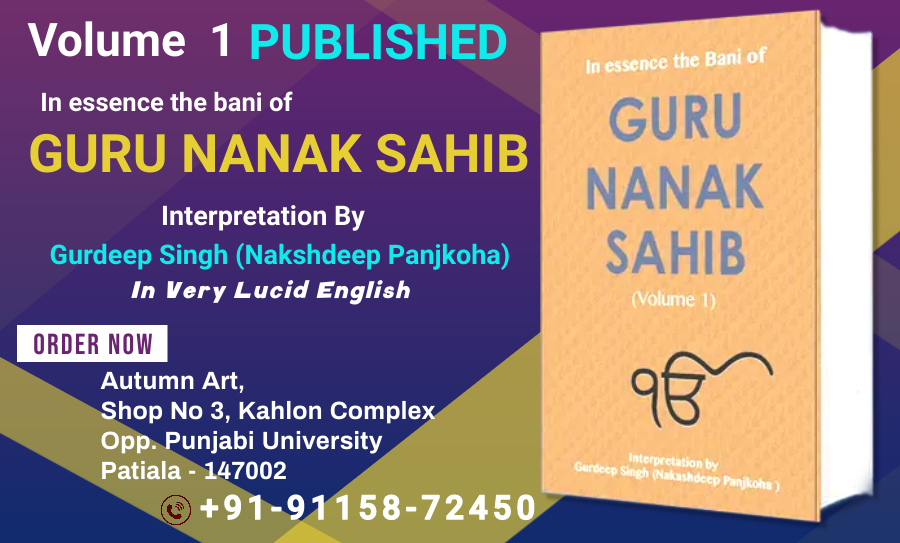In the spiritual realms, a unique stage of mind is expressed in Sri Guru Granth Sahib; it is usually named as “Sehaj Awastha”. Sehaj literally means natural; obviously, the usual stage in which the human mind dwells is a disturbing commotion of the worldly affairs, desires, lust, greed, anger and conceit; therefore, it is not natural; instead it is created by the said commotion. In the “sehaj Awastha” the mind remains detached and gets elevated much higher than the said commotion. This stage is expressed in very clear manners in the Gurbani. Please look on 333, SGGS:
ਗਉੜੀ ॥
ਤਹ ਪਾਵਸ ਸਿੰਧੁ ਧੂਪ ਨਹੀ ਛਹੀਆ ਤਹ ਉਤਪਤਿ ਪਰਲਉ ਨਾਹੀ ॥
ਜੀਵਨ ਮਿਰਤੁ ਨ ਦੁਖੁ ਸੁਖੁ ਬਿਆਪੈ ਸੁੰਨ ਸਮਾਧਿ ਦੋਊ ਤਹ ਨਾਹੀ ॥੧॥
Ga▫oṛī.
Ŧah pāvas sinḏẖ ḏẖūp nahī cẖẖahī▫ā ṯah uṯpaṯ parla▫o nāhī.
Jīvan miraṯ na ḏukẖ sukẖ bi▫āpai sunn samāḏẖ ḏo▫ū ṯah nāhī. ||1||
Raag Gauri.
In essence: (Bhagat Kabir describes the state of mind called Sehaj / Dasam Dawar/Equipoise in which the mind gets imbued with the Creator) In equipoise, Sehaj, there is no acknowledgment of rainy season, sea, sunshine, shade, creation or destruction, life or death, pain, comforts and duality (through this metaphoric expression, Bhagat Kabir expresses how one’s mind becomes stable even when one lives in the Maya controlled world); it is a sheer meditation in emptiness (the state of void).
The mind, being imbued with the Creator, stops acknowledging the existence of hope, desires, and so on. Everything in Akalpurakh’s show remains active, but the mind gets free from the Maya influences. It is a sublime experience for the mind. It is an amazing state of mind! It is also called “Dasm Duar /Tenth gate” through which Aalpurakh is envisioned. It is explained many times in the Gurbani to inspire others to get in it. To reach to such a kind of state of mind is not that simple; it needs hard work, but once it is obtained, the mind learns to settle in it repeatedly. Never forget that to obtain that “Sehaj”, Akalpurakh’s grace is mandatory.
ਸਹਜ ਕੀ ਅਕਥ ਕਥਾ ਹੈ ਨਿਰਾਰੀ ॥
ਤੁਲਿ ਨਹੀ ਚਢੈ ਜਾਇ ਨ ਮੁਕਾਤੀ ਹਲੁਕੀ ਲਗੈ ਨ ਭਾਰੀ ॥੧॥ ਰਹਾਉ ॥
Sahj kī akath kathā hai nirārī.
Ŧul nahī cẖadẖai jā▫e na mukāṯī halukī lagai na bẖārī. ||1|| rahā▫o.
The description of “Sehaj” is inexpressible and unique. It can neither be measured, nor be exhausted. The feelings in Sehaj are neither light nor heavy (they are in completely balanced). Pause.
Basing on Bhagat Kabir’s expression of the Sehaj, I have tried to explain it, but still it is not perfectly expressed, because it cannot be explained in words; one can know it fully only by experiencing it.
On 68, SGGS, Third Nanak goes in detail about Sehaj Awastha
ਸਿਰੀਰਾਗੁ ਮਹਲਾ ੩ ॥
ਸਹਜੈ ਨੋ ਸਭ ਲੋਚਦੀ ਬਿਨੁ ਗੁਰ ਪਾਇਆ ਨ ਜਾਇ ॥
ਪੜਿ ਪੜਿ ਪੰਡਿਤ ਜੋਤਕੀ ਥਕੇ ਭੇਖੀ ਭਰਮਿ ਭੁਲਾਇ ॥
ਗੁਰ ਭੇਟੇ ਸਹਜੁ ਪਾਇਆ ਆਪਣੀ ਕਿਰਪਾ ਕਰੇ ਰਜਾਇ ॥੧॥
Sirīrāg mėhlā 3.
Sahjai no sabẖ locẖḏī bin gur pā▫i▫ā na jā▫e.
Paṛ paṛ pandiṯ joṯkī thake bẖekẖī bẖaram bẖulā▫e.
Gur bẖete sahj pā▫i▫ā āpṇī kirpā kare rajā▫e. ||1||
Raag Sree Raag, the bani of Third Nanak.
In essence: All people want to be in equipoise (It is the only close word to sehaj in English, which means a balanced state of mind, in other words: a state of void), but it cannot be obtained without the Guru. The Pundits, the astrologers, and the other sectarians have grown weary of extensive study, but their doubt has deluded them. When Prabh bestows His grace, the Guru is met and the equipoise is obtained.
ਭਾਈ ਰੇ ਗੁਰ ਬਿਨੁ ਸਹਜੁ ਨ ਹੋਇ ॥
ਸਬਦੈ ਹੀ ਤੇ ਸਹਜੁ ਊਪਜੈ ਹਰਿ ਪਾਇਆ ਸਚੁ ਸੋਇ ॥੧॥ ਰਹਾਉ ॥
Bẖā▫ī re gur bin sahj na ho▫e.
Sabḏai hī ṯe sahj ūpjai har pā▫i▫ā sacẖ so▫e. ||1|| rahā▫o.
Oh brother! The equipoise is not obtained without the Guru. Through the Guru’s shabda, the equipoise occurs and Har is obtained. Pause.
On 739, SGGS Fifth Nanak expresses about Sehaj:
ਸੂਹੀ ਮਹਲਾ ੫ ॥
ਸੂਖ ਮਹਲ ਜਾ ਕੇ ਊਚ ਦੁਆਰੇ ॥
ਤਾ ਮਹਿ ਵਾਸਹਿ ਭਗਤ ਪਿਆਰੇ ॥੧॥
Sūhī mėhlā 5.
Sūkẖ mahal jā ke ūcẖ ḏu▫āre.
Ŧā mėh vāsėh bẖagaṯ pi▫āre. ||1||
Raag Soohi, the bani of Fifth Nanak.
In essence: The state of mind where Prabh is realized is very high and His dear devotees live in that state.
ਸਹਜ ਕਥਾ ਪ੍ਰਭ ਕੀ ਅਤਿ ਮੀਠੀ ॥
ਵਿਰਲੈ ਕਾਹੂ ਨੇਤ੍ਰਹੁ ਡੀਠੀ ॥੧॥ ਰਹਾਉ ॥
Sahj kathā parabẖ kī aṯ mīṯẖī.
virlai kāhū neṯarahu dīṯẖī. ||1|| rahā▫o.
Prabh’s praise done in equipoise is very sweet, but rare is the one, who has personally experienced it. Pause.
ਤਹ ਗੀਤ ਨਾਦ ਅਖਾਰੇ ਸੰਗਾ ॥
ਊਹਾ ਸੰਤ ਕਰਹਿ ਹਰਿ ਰੰਗਾ ॥੨॥
Ŧah gīṯ nāḏ akẖāre sangā.
Ūhā sanṯ karahi har rangā. ||2||
In there is the arena of songs of Har’s praise and melody. In there, Har’s devotees enjoy His love.
ਤਹ ਮਰਣੁ ਨ ਜੀਵਣੁ ਸੋਗੁ ਨ ਹਰਖਾ ॥
ਸਾਚ ਨਾਮ ਕੀ ਅੰਮ੍ਰਿਤ ਵਰਖਾ ॥੩॥
Ŧah maraṇ na jīvaṇ sog na harkẖā.
Sācẖ nām kī amriṯ varkẖā. ||3||
In that state of mind, the rain of His name-nectar falls, and in there, any fear of birth, longing to live long, and feelings of pain and happiness do not exist.
It is a special state of mind which is being expressed through which the mind stills completely; therefore, we should not take the meanings of words like Maran/death, jivan/life literally; it is an expression of an experience materialized in the state of equipoise. The following verses make it clear that it is all about equipoise.
ਗੁਹਜ ਕਥਾ ਇਹ ਗੁਰ ਤੇ ਜਾਣੀ ॥
ਨਾਨਕੁ ਬੋਲੈ ਹਰਿ ਹਰਿ ਬਾਣੀ ॥੪॥੬॥੧੨॥
Guhaj kathā ih gur ṯe jāṇī.
Nānak bolai har har baṇī. ||4||6||12||
This secret discourse about that state of mind is known through the Guru. Nanak utters the the bani of Har’s praise.
Sehaj dawns in one’s mind when one gets rid of one’s duality. In that state of mind, only Akalpurakh, the Creator, exists and the rest appears to be His manifestation. In Sehaj, one sees negativity and positivity in the world, but one never reacts to the negativity negatively. In that very state of mind, the world looks very different; in the following Shabda, Fifth Nanak expresses how the world appears while being in Sehaj filled with Akalpurakh’s presence:
ਕਾਨੜਾ ਮਹਲਾ ੫ ॥
ਬਿਸਰਿ ਗਈ ਸਭ ਤਾਤਿ ਪਰਾਈ ॥
ਜਬ ਤੇ ਸਾਧਸੰਗਤਿ ਮੋਹਿ ਪਾਈ ॥੧॥ ਰਹਾਉ ॥
Kānṛā mėhlā 5.
Bisar ga▫ī sabẖ ṯāṯ parā▫ī.
Jab ṯe sāḏẖsangaṯ mohi pā▫ī. ||1|| rahā▫o.
Raag Kanrha, the bani of Fifth Nanak
In essence: Since I have attained the company of the true devotees of the Creator, and I have totally forgotten how to feel jealous of others. (Pause)
The Guru explains how environmental influence of the devotees directs one’s mind toward the Creator; consequently, the greed and the desire (to have more and more) just go away from it. Question of feeling jealous of others doesn’t rise at all then, and one lives in Sehaj.
ਨਾ ਕੋ ਬੈਰੀ ਨਹੀ ਬਿਗਾਨਾ ਸਗਲ ਸੰਗਿ ਹਮ ਕਉ ਬਨਿ ਆਈ ॥੧॥
Nā ko bairī nahī bigānā sagal sang ham ka▫o ban ā▫ī. ||1||
I have become a friend of all; now there is no enemy or a stranger.
In that state, the mind, also known as “Sehaj Awastha/ free from the three modes of Maya, remains imbued with the Creator”, and its duality totally vanishes. The duality, thinking that this person is mine and that person is not and loving others instead of the creator, ceases. And, the faith in Ekankar’s presence in His creation changes one’s thinking. As a result of that, one’s behavior toward His creation turns harmonious.
ਜੋ ਪ੍ਰਭ ਕੀਨੋ ਸੋ ਭਲ ਮਾਨਿਓ ਏਹ ਸੁਮਤਿ ਸਾਧੂ ਤੇ ਪਾਈ ॥੨॥
Jo parabẖ kīno so bẖal māni▫o eh sumaṯ sāḏẖū ṯe pā▫ī. ||2||
Whatever Akalpurakh does, I accept it as good, and this wisdom, I have obtained through the Guru.
This is another way of expressing total faith in Har’s Ordinance while being enjoying the state of equipoise. Fifth Nanak was physically tortured. The History confirms that no diplomacy or other kinds of strategies were used to avoid that calamity; The Guru kept his faith intact in the Creator and refused to bow to the mind-slaves; endured all what came by. In Sehaj, he saw nothing but His ordinance; obeying His ordinance eliminates all fears. The torture he went through was a kind of satisfaction of the conceit-led-individuals, and it was also a part Har’s show. Those persons, who participated in that show, got into heinous crime–game, which never allowed them to acquire decency and compassion? As per Har’s Ordinance, another time came and His show took another turn. In that new turn, the Guru’s followers were taught how to do self-defense, which changed the course of the History of India. Those, who wanted to enforce their religious views on others, were reduced to powerless as the time elapsed.
In the above verses, the Guru stresses on obeying Har’s ordinance as it comes by without complaining against it. A Sant Guru, who was only into directing the mortals towards the Creator, was victimized by the conceit of some individuals. That conceit needed to be corrected and the Creator did it eventually. This way, Har’s show goes on, so does His Ordinance. In His show, there are varieties of good and evil to witness. The Guru suggests here to acknowledge it as Har’s error-free ordinance, which becomes easier to follow when one dips into the equipoise.
ਸਭ ਮਹਿ ਰਵਿ ਰਹਿਆ ਪ੍ਰਭੁ ਏਕੈ ਪੇਖਿ ਪੇਖਿ ਨਾਨਕ ਬਿਗਸਾਈ ॥੩॥੮॥
Sabẖ mėh rav rahi▫ā parabẖ ekai pekẖ pekẖ Nānak bigsā▫ī. ||3||8||
(Living in the company of His true devotees and equipoise, the mind sees the Creator all over) Oh Nanak! I am joyful to see Akalpurakh permeating all the beings.
You cannot just preach such thought unless you live this thought, and once you do so, opposition becomes eminent. The Guru proved this fact with his life.
The Sikh Gurus strictly practiced what they preached, and that alone factor keeps them separate from all others, who were either in competition with them or in opposition. They Gurus taught and held virtues high contrary to those, who got drowned in Maya while feeding their own conceit. Interestingly, for the drowned ones, the Guru offers forgiveness since they were just acting as per the inspiration of the given conceit. As His devotee gets elevated high above personal bondage enveloped in burning conceit, he or she sees no presence of enmity, revenge and ill intellect but positivity in force to neutralize the negativity that leads to destruction.
Humbly
Gurdeep Singh





